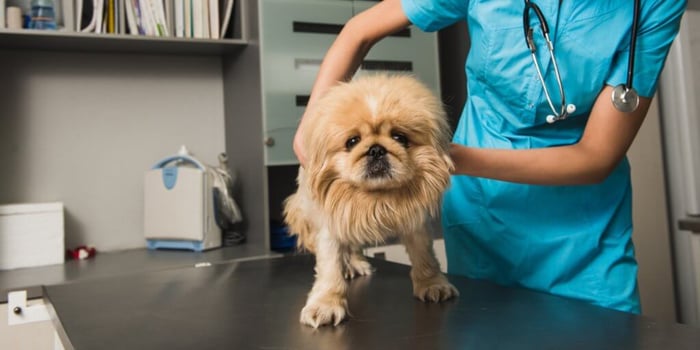What Is PennHIP? PennHIP is a radiographic screening method for hip evaluation.
This technique assesses the quality of the canine hip and quantitatively measures canine hip joint laxity.
The PennHIP method is more accurate than the current standard in its ability to predict the onset of osteoarthritis (OA). Osteoarthritis, also known as degenerative joint disease (DJD), is the hallmark of hip dysplasia (HD).
PennHIP is composed of three major components: a diagnostic radiographic technique, a network of trained veterinarians, and a medical database used for scientific analysis.
PennHIP has published more than 40 manuscripts over the past 20 years. As this database expands, the PennHIP laboratory is able to better answer questions regarding the etiology, prediction, and genetic qualities of canine hip dysplasia.
At the present time, roughly 3,000 veterinarians around the globe are capable of performing the PennHIP test on their canine patients. Further, the tools developed by PennHIP assist veterinarians and those involved in dog breeding to reduce the risk of canine hip dysplasia by implementing selective breeding strategies.
 Hip-Extended View
Hip-Extended View Distraction View
Distraction View Compression View
Compression ViewWhat Does PennHIP Stand for?
PennHIP stands for the University of Pennsylvania Hip Improvement Program. It was developed by Gail K. Smith, a Comparative Medical Sciences Graduate Group member at the University of Pennsylvania School of Veterinary Medicine.
What Is the History of PennHIP?
In 1983, Dr. Gail Smith conceived and developed a new scientific method for the early diagnosis of CHD while at the University of Pennsylvania School of Veterinary Medicine. Dr. Smith completed his undergraduate degree in engineering, then attended veterinary school at the University of Pennsylvania where he received his degree and then went on to earn a PhD in materials science engineering.
After that, he completed his orthopedic surgery residency and began his tenure as a faculty member of the University of Pennsylvania School of Veterinary Medicine. This intersection of veterinary medicine and engineering is what led to the development of PennHIP. Smith was highly interested in both, and once he was appointed to the faculty of the veterinary school, all of his knowledge and the materials available to him came together. Smith was concerned with canine hip health, and this new series of procedures provided a level of accuracy and clinical excellence that had previously not been met.
The PennHIP method was used as a clinical tool beginning in 1993. Three years later, a patent was issued to Smith. He has been recognized by the American Veterinary Medical Association as well as the American Kennel Club. The British Small Animal Veterinary Association has awarded him the Blaine Award, and the World Small Animal Veterinary Association has awarded him the Iams Saki Paatsama Award.
PennHIP was once licensed to a corporation, but Smith took it back in 2002 and turned it into a not-for-profit service at the University of Pennsylvania School of Veterinary Medicine. Recently, Antech Imaging Services purchased PennHIP, and the name is now AIS PennHIP.
How Does PennHIP Compare to Other Methods?
The most popular and widely accepted way of determining whether a dog has hip dysplasia is to use the Orthopedic Foundation for Animals hip joint scoring method. This is often referred to as “OFA certification.”
A dog’s hips will be scored as Excellent, Good, Fair, Borderline, Mild, Moderate, or Severe. Breeders will generally avoid breeding dogs with Borderline, Mild, Moderate, or Severe hip dysplasia and will be cautious in breeding those with Fair hips. PennHIP, on the other hand, scores (distraction index ) a dog’s hips on a scale from 0 to 1.
A dog with a score closer to 0 has very tight hips, while a dog with a score of 1 would have very loose (subluxated) hips. PennHIP is more sensitive than OFA testing, and many dogs that have been rated as OFA Excellent or Good showed a predisposition to hip dysplasia, based on their higher DI according to the PennHIP method. (A score greater than 0.30 means that the dog has a higher risk of developing osteoarthritis.)
In a study published in the Journal of the American Veterinary Medical Association, it was reported that 14% (60/439) of dogs had hip joints scored as excellent by OFA standards; however, 52% (31/60) of those had a DI ≥ 0.30 (range, 0.14 to 0.61). Eighty-two percent of (183/223) dogs with OFA-rated good hip joints had a DI ≥ 0.30 (range, 0.10 to 0.77), and 94% (79/84) of dogs with OFA-rated fair hip joints had a DI ≥ 0.30 (range, 0.14 to 0.77). Of all dogs with fair to excellent hip joints by OFA standards, 80% (293/367) had a DI ≥ 0.30.
All dogs with OFA-rated borderline hip joints or mild, moderate, or severe hip dysplasia had a DI ≥ 0.30 (range, 0.30 to 0.83). There are other differences between the two methods. OFA testing requires one radiograph, can be done without sedation on a dog over the age of two years old, and the radiographs submitted by the owner if they so choose.
PennHIP requires three specific radiographs, must be done under sedation or general anesthesia, can be done on any dog as early as 16 weeks of age, and the radiographs done by the certified PennHIP veterinarian must be submitted to the analysis center.
While OFA testing costs approximately $35 in addition to the radiograph fee and the veterinary office fees, PennHIP costs between $200 and $400.
Finally, the results of OFA certification are accepted by the American Kennel Club, while those from PennHIP testing have not yet been approved. Talk to your veterinarian about which type of testing for osteoarthritis and hip dysplasia is right for your dog.









